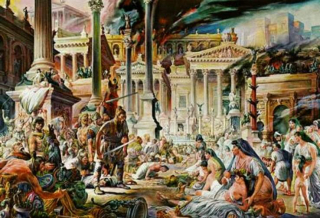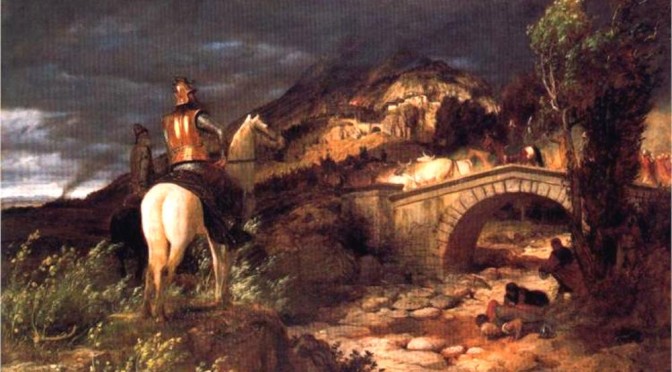In the summer and fall of 376, under pressure from the advancing Huns, tens of thousands of displaced Goths crossed the Danube River, on the border of the Roman Empire. The roman emperor, Valens agreed to accept them as he planned to use them to increase the size of his army. They came with an impediment, they believed in a different form of christianity. They were said to be Arian,whose main difference from orthodoxy was a theological concern about the nature of Jesus, but they were known to be something else as well Dualists, they believed in two gods. The subsequent history of the Goths suggests that they were Cathars.
 In the summer and fall of 376, under pressure from the advancing Huns, tens of thousands of displaced Goths crossed the Danube River, on the border of the Roman Empire. The roman emperor, Valens agreed to accept them as he planned to use them to increase the size of his army. They came with an impediment, they believed in a different form of christianity. They were said to be Arian,whose main difference from orthodoxy was a theological concern about the nature of Jesus, but they were known to be something else as well Dualists, they believed in two gods. The subsequent history of the Goths suggests that they were Cathars.
In the summer and fall of 376, under pressure from the advancing Huns, tens of thousands of displaced Goths crossed the Danube River, on the border of the Roman Empire. The roman emperor, Valens agreed to accept them as he planned to use them to increase the size of his army. They came with an impediment, they believed in a different form of christianity. They were said to be Arian,whose main difference from orthodoxy was a theological concern about the nature of Jesus, but they were known to be something else as well Dualists, they believed in two gods. The subsequent history of the Goths suggests that they were Cathars.
Attempts to convert the Goths were strenuously resisted and so a program of discrimination commenced. Rome failed to supply them with either the food they were promised or lands they could farm; they herded the Goths into a temporary holding area surrounded by an armed Roman garrison and left the the Goths to starve. The Romans provided a grim alternative: the trade of slaves (often children and young women) for dog meat. The Romans provided the male Goths with paid service in the army but then used them continually in the front line holding the legions in reserve. there seemed to be no concern for Gothic losses and worse still their women and children still in the guarded camp were subject to brutality and rape. Open revolt began.
After an open war lasting six years in which they defeated Valens and occupied most of Illyrica (Serbia and Croatia) they made peace and settled into lands close to the Danube but under substantially better conditions. They still suffered discrimination and sporadic attacts. Eventually the decision was take to move to an are where the poulace shared the same religious beliefs, the area they chose was Occitan. On the way there, they conducted extended negotiations with The Emperor and senate of Rome. They wanted to be made autonomous by a grant of land away from the Danube, monetary compensation for their suffering, and access to the Roman grain from North Africa. The negotiations ended in 410 with the Gothic occupation of Rome, which has become notorious as “The Sack of Rome”.
However:-
‘The sack of Rome was by all accounts of little material significance in the long and complex history of Roman engagement with barbarians; it was in fact the Goths’ third visit to the city in three years, and on the previous occasion the senate had allowed them into Rome and collaborated with them in setting up the prefect of the city as emperor in opposition to Honorius, whose administration was based in Ravenna. Contemporary historians emphasized that the forces of the western empire had recovered their dominance within just three or four years at most, and recent historians have seen the attack on Rome as representing a failure on the part of the Goths, who had hoped to use the threat to Rome as a bargaining tool with the emperor in their pursuit of land and supplies. Honorius and his government seem to have been relatively untroubled. On the day after Alaric’s seizure of Rome Honorius had time, from his palace in Ravenna, to issue an edict ordering that religious dissension among Christians in North Africa should cease and summoning a conference of all the Catholic and Donatist bishops to examine their dierences. The Liber pontificalis manages to give a quite detailed account of the time of Pope Innocent I (402–17) and his good works without once mentioning the Goths or the attack on Rome (Orosius explains that he happened to be away in Ravenna at the time). But the event acquired remarkable prominence, and a distinctive significance, in the Anglo-Saxon perception of their past, especially in the Alfredian period: it is mentioned prominently in two of Bede’s historical works, in four of the Old English prose works associated with King Alfred, and in Æthelweard’s Chronicle; it is the context and end-point of the Old English version of Orosius’sHistory of the World; and it is the starting-point of King Alfred’s account of Boethius. I want here to explore its developing significance for the Anglo-Saxons, and particularly for the Alfredian world.”
Anglo Saxon England M R Godden entitled:-
The Anglo-Saxons and the Goths: rewriting the sack of Rome
Bede was writing in 710 about an event which took place 300 years earlier. He was a cleric of the Roman Church’s mission to Britain and was still involved in the struggle to eliminate “Celtic Christians”. His exaggerated version of the sack of Rome has influenced historical thinking ever since. His message undoubatably was “See how wicked these Arians (and by association Celtic Christians) are it is your duty to eliminate them”
One of the terms by which the Pope gave his approval of William of Normandy in 1066 was that he eliminated the alternative christianity from the whole of the British Isles. The battle continued!
